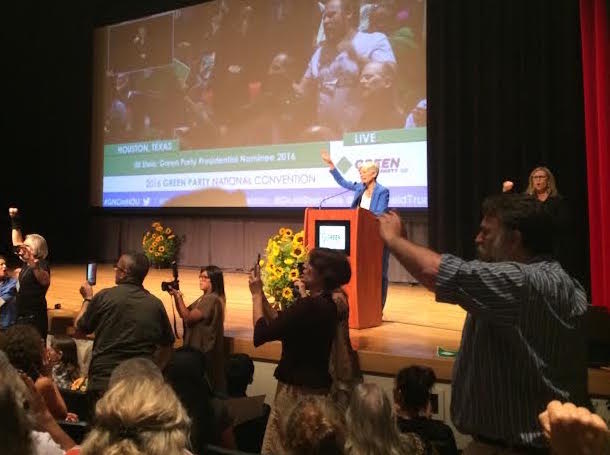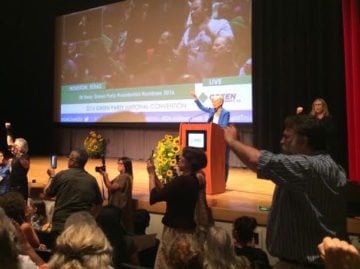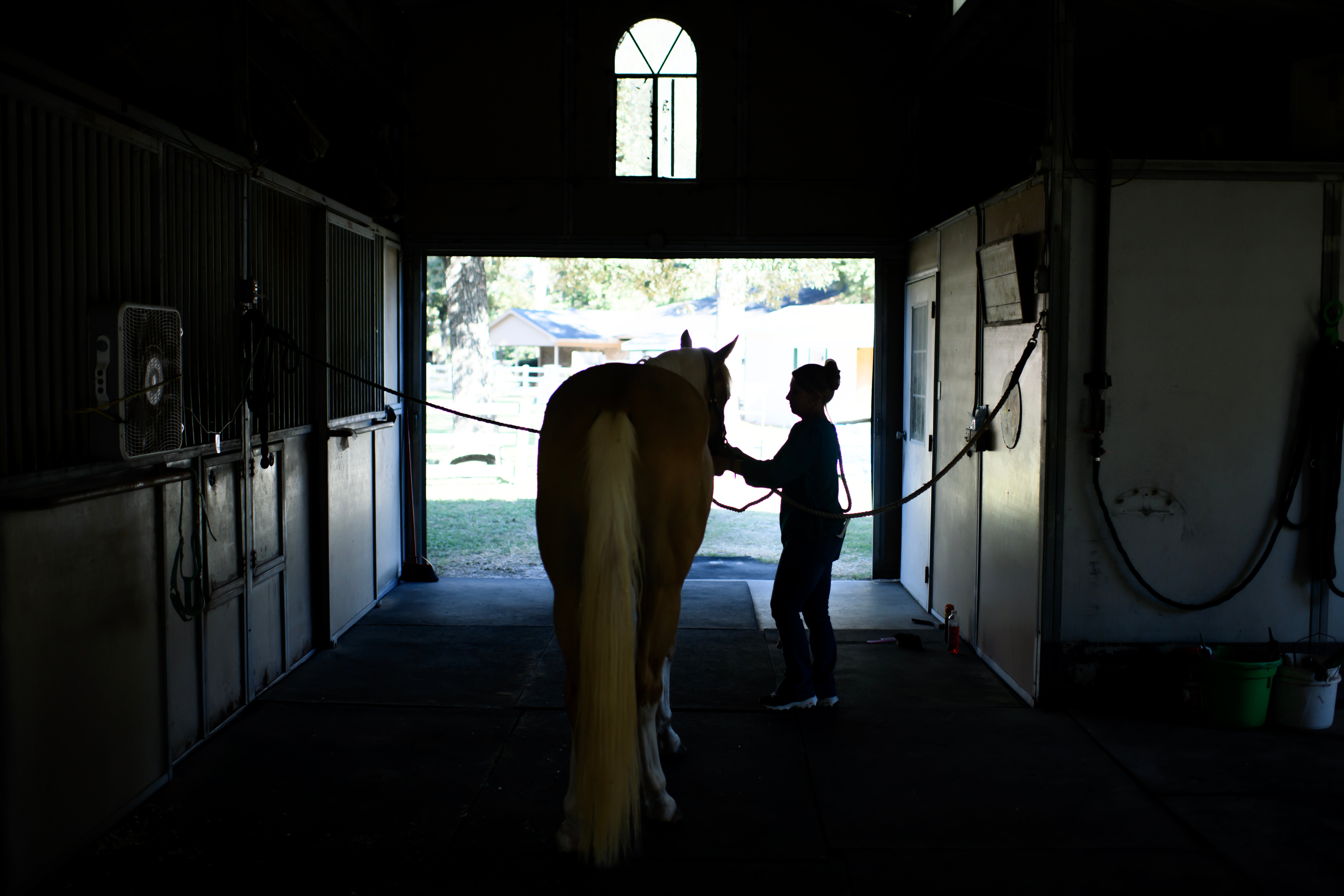
The Texas Green Party Isn’t Making It Any Easier to be Green


The Green Party’s national convention, which took place in the student center at the University of Houston this weekend, was an unusual affair. Some 450 people, from all 50 states, converged to nominate a presidential candidate amid bemused undergrads and broken vending machines. Despite the setting, Green delegates seemed greatly excited. The party is experiencing something of a national moment, thanks to discontent from some former Bernie Sanders supporters.
But it’s a strange moment for the Green Party of Texas, which, if not exactly influential in the state, is more relevant than some of the other Green state parties. In the past, the congenital weakness of Texas Dems has created some exploitable loopholes in Texas, but Democrats have closed them this year. That poses a more or less existential threat to the Green Party, and raises some questions about the Greens’ strategy, if that’s not too generous a term.
In Texas, a party needs to win at least 5 percent of the vote in a statewide race to gain a line on the next election’s ballot. If they don’t, a party would have to collect something in the neighborhood of 100,000 signatures to gain ballot access, a tough task for a small group.
Greens have cleared that 5 percent threshold in the past by running candidates for state judicial races where no Democrats are running. That’s how they won ballot access for 2016. But this year, Democrats are running a token candidate in every statewide race, which means if no Green wins 5 percent in a race with two main candidates — a steep climb — they’ll be off the ballot in 2018 — barring a tough and expensive petition drive. And, maybe, off the ballot for the foreseeable future.
In the past, the congenital weakness of Texas Dems has created some exploitable loopholes in Texas, but Democrats have closed them this year.
Amusingly, Salinas appropriated the age-old language of Texas Democrats to argue for her party. Texas wasn’t an inherently Republican state, she said, but a low-turnout state. “If we could have everyone vote who was eligible to vote,” Salinas said, “this place would be Green.”
But she also posited that votes for Democratic and Green candidates are equally valueless, something you don’t hear politicians say very often. “Let’s address the issue of a wasted vote. How many of you have heard that?” she asked, to chuckles in the crowd. “Texas is so red, a blue vote is a wasted vote.” It was her biggest applause line.
Herb Gonzales Jr., a Green delegate from San Antonio took up the task of announcing the Texas delegation’s support for “the wonderful, the precious, the leader,” Jill Stein. Gonzales said that Texas Greens had seen growing membership and interest in the party since the spring, as the Democratic primary started to lose its excitement. “The party has really come together in the last four months,” he said. Finally, he said, the Greens could say that they were “a growing party.”
The loss of ballot access would certainly put a stop to that. But what was the party achieving with ballot access? After winning access in 2000, losing it in 2002, and then securing it again in 2010 — thanks in large part to Republican consultants who “helped” the Green Party gather the necessary signatures — it doesn’t have much to show. The party still has a very limited geographic footprint — only 14 county parties are officially affiliated with the state Greens. So why chase statewide races?
“You have to run statewide races in Texas,” Gonzales told the Observer, thanks to Texas election law. Ballot access had to be the first priority of the party, he said. Asked if there were notable local races this year, Gonzales pointed to three congressional candidates in San Antonio — but added that there were some justice of the peace seats being contested, school board races, and the like.
But what is the Green theory for political progress in Texas? A presidential bid like Stein’s makes sense for a marginal political movement, because it creates buzz and raises awareness across the country. But the Greens’ bids for statewide office in Texas don’t create the same kind of enthusiasm — the only Green candidate to garner attention in the 2014 cycle was the nominee for U.S. Senate, Emily “SpicyBrown” Sanchez, who won some media attention more or less because of her name. And they’re the most expensive, most logistically difficult elections the Greens could contest.
The Greens are fielding candidates in 20 of the state’s 36 congressional districts. These are expensive and difficult races where there is a vanishingly small chance for significant forward progress, let alone an upset.
Elsewhere in the country, the Greens have notched some successes in local elections, winning positions as minor as a seat on the board governing the Mosquito Control District of the Florida Keys, but also fairly one prominent ones: A green served as the mayor of Santa Monica for eight years. Outside the Green Party, figures like Kshama Sawant, the socialist city councilmember in Seattle, show how minor electoral victories in the right places can significantly elevate the profile of small social movements.
In Texas, the Greens currently have George Altgelt, a city councilmember in Laredo, and they were once the party of the mayor of Marfa. Libertarians, too, hold elected office in a few small Texas towns. For both parties, nonpartisan municipal elections provide at least a shot at generating momentum in communities and introducing their movements to new people. As red as most of Texas is, there are at least a few deep-blue pockets in which far-left organizing could take place — and Greens in other places have garnered cross-ideological support by focusing on local issues.
There’s a reason Republicans wanted Greens on the ballot in 2010: They’re the only people who really benefit from having them run statewide in Texas.
Like any political movement, the Sanders’ coalition, now breaking apart, contained different and sometimes contradictory tendencies. Some, with a more practical eye to the proceedings of the last year, saw Sanders’ unlikely success as a vehicle, and look now to exploitable opportunities within the existing political system. Others saw in the Sanders campaign a pop-up community defined by ideological purity, and are seeking that elsewhere.
The Greens are a natural home for the second group. Texas Democrats, so often cordial with big oil and payday lenders, don’t tend to offer much to young, passionate people, so the instinct to find a home elsewhere is understandable. But, at least for the foreseeable future, the Greens of Texas are effectively taking that enthusiasm, flattening it out, and feeding it carefully into a shredder.


